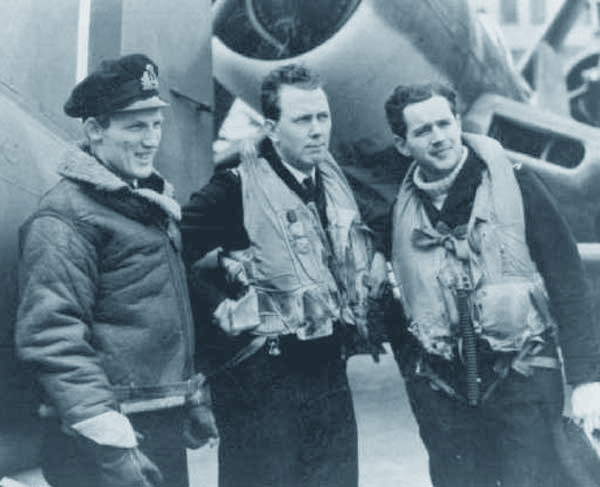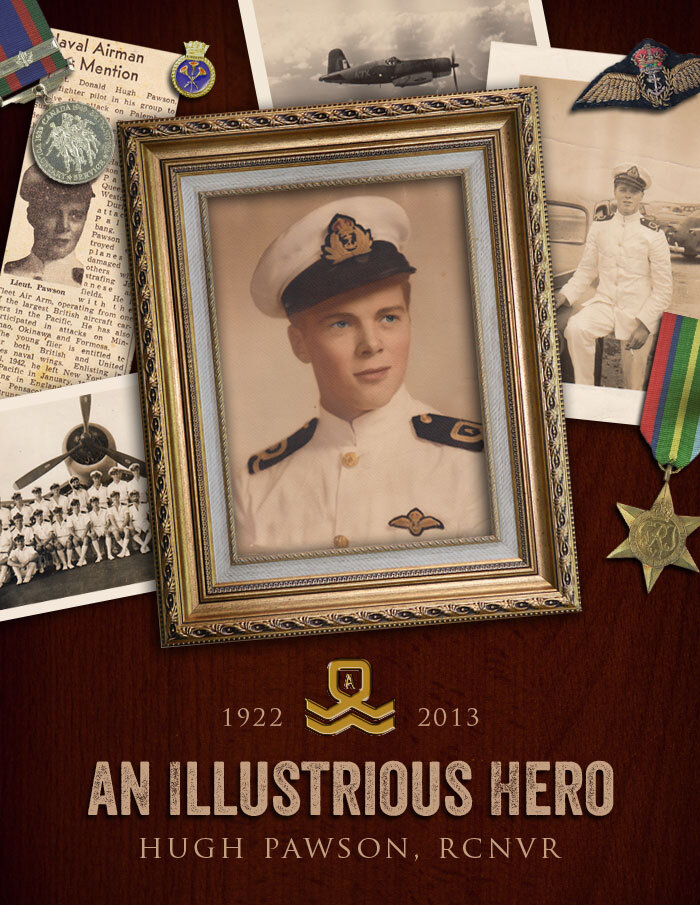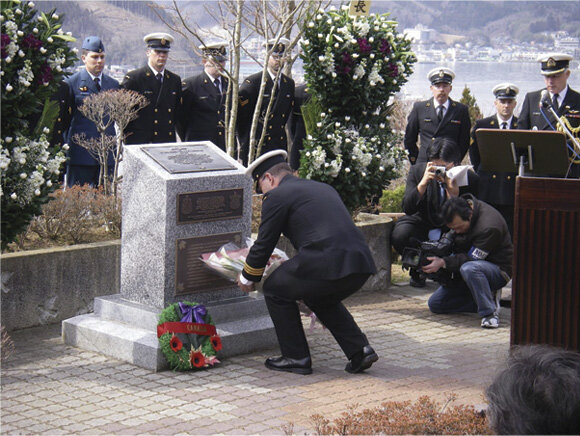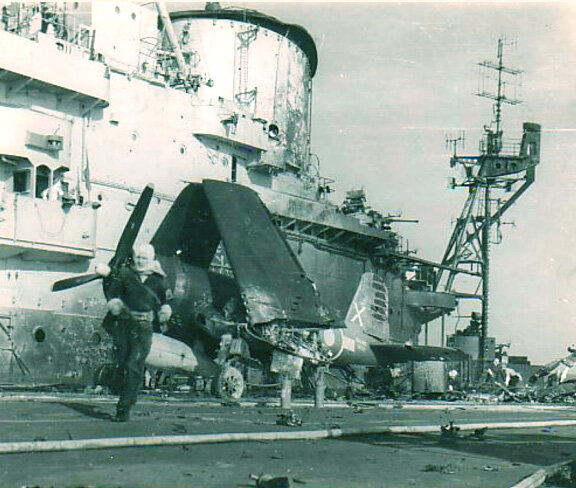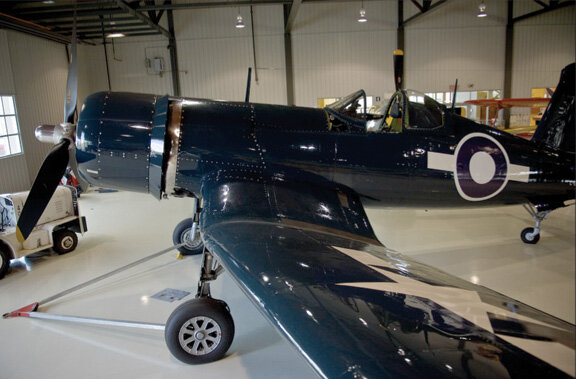THE ROYAL TREATMENT
The Goodyear FG-1D Corsair presently owned and operated by Vintage Wings of Canada was acquired for only one reason - to tell the story of Canada's naval fighter pilots from the Second World War. There were many courageous and highly skilled Canadian flyers who served with Britain's Senior Service - the Royal Navy Fleet Air Arm. Of these, two are especially renowned for their exploits and courage under fire flying Corsair fighter aircraft from fleet carriers in the Atlantic and Pacific theatres. One survived, one did not.
The first and perhaps greatest of all was Sub-Lieutenant Don Sheppard, DSC of Toronto, a Corsair pilot with 1836 squadron aboard HMS Victorious. This remarkable aviator holds the unique distinction of being the only Corsair ace in the Royal Navy - with five kills to his credit in the Pacific theatre. Don Sheppard is a highly revered fighter pilot with an unequaled career who is regarded as one of the finest pilots to have ever flown the Corsair anywhere. Today, Sheppard lives in Aurora, Ontario.
The other widely known Canadian naval aviator from the Second World War is Lieutenant Robert Hampton “Hammie” Gray, VC, DSC, who was much loved by his 1841 Squadron mates aboard HMS Formidable and who was highly regarded as a flight commander and aggressive pilot. It was, however, the manner of his death that makes him so well known to Canadians. Gray died in the final few days of the war when the Corsair he was flying was shot down as he was attacking a Japanese warship in Japanese home waters. The facts are well known and yet still the focus of speculation and interest more than sixty years after his death.
Because of his compelling story, ultimate sacrifice and because he was the last Royal Navy pilot and last Canadian to be awarded the Victoria Cross, we selected Robert Hampton Gray as the pilot to be honoured with our Corsair. But in fact it is all Royal Navy pilots, Canadian and others who we honour with this flying tribute.
Lt. Ron Hayter, Lt. Don "Pappy" McLeod and Lt. Don J. Sheppard stand before one of their camouflaged Corsair aircraft aboard HMS Victorious. The best known aircraft flown by Sheppard was one of these tropic sea camo painted Corsairs. Unfortunately our all-blue Goodyear Corsair is more easily transformed into Gray’s aircraft. Photo: www.acesofww2.com
The Vintage Wings of Canada Corsair spent the winter months being checked out and readied for the 2008 flying season. During all that time she wore the “stars and bars” of the United States Navy/Marine Corps. With great respect and admiration for our American colleagues, it was not the story we wanted to tell and she stood out like a Bald Eagle among Canada Geese. There has been much discussion over the past year concerning the final paint scheme to be applied to our Corsair but for the 2008 flying season it was decided that at the very least we should alter the existing US paint scheme to make her a Royal Navy Corsair.
This turned out to be quite easy to do given the fact that the Corsair was an almost blank canvas in blue. Royal Navy roundels were created to cover the star centres of the US markings and the rest was history - Royal Navy history. The application of these roundels and markings was so successful that for the foreseeable future, she will remain in this spectacular scheme.
The Vintage Wings of Canada Goodyear-built Corsair flies in formation with another Corsair. The Corsair in the foreground is painted to represent VF-17, The Jolly Rogers, a US Navy unit from the Second World War. The VWC Corsair is painted in “as delivered” condition - the way it came from the Goodyear factory and before it was assigned to an American Navy or Marine unit. This no name scheme, while historically correct in every way, certainly misses the opportunity to tell a story about the men who risked their lives flying fighters from carriers in the Pacific. It was now time to alter this paint scheme through the use of large scale “decals” and turn her into the most famous Corsair to have been flown by a Canadian in the war. Photo: Doug Fisher, www.warbirddepot.com
Pilots of the Fleet Air Arm squadrons aboard His Majesty’s Ship Formidable beam with pride and youthful elan in front of their Corsair F4U-1s. Inset above: Lt. Robert Hampton Gray of Nelson, British Columbia in his formal Royal Navy photograph. Inset below: A souvenir pennant from Formidable.
Related Stories
Click on image
In 2006, officers of the Canadian Navy and Air Force place a wreath at the memorial to Robert Hampton Gray on the shores of Onagawa Bay in Japan. Gray’s marker is the only memorial dedicated to a member of any Allied armed force on the Japanese main islands. Gray’s aircraft crashed into the waters in the background, killing him in the final days of the war. DND Photo
The only photo yet to be found that shows the original Corsair number 115 of the Royal Navy’s 1841 Squadron. It is generally accepted that No. 115 was not “Hammie” Gray’s usual aircraft, as his was unserviceable at the time that he launched from Formidable on that fateful day. Here we see 115 chained and battened down for inclement weather enroute to some action - with engine cowl and canopy covered in canvas to protect them from the effects of salt spray. Inset - the squadron crest for 1841 shows an eagle preying on a dragon above the waves - a heraldic depiction of Robert Hampton Gray’s final action when he pressed home his attack on the Japanese destroyer Amakusa, sinking her in Onagawa Bay.
This photo showing the aftermath of a Kamikaze strike on HMS Formidable two months before Gray’s final flight. It also shows our team the placement of the ship deck code code (the letter “X” was worn by all aircraft aboard Formidable) and that there seems to be no set position for the Royal Navy titles aft of the roundel. In other RN photos in the Pacific Theatre, these titles are in varying positions. The ship deck code was also painted on the deck of RN carriers to prevent returning aircraft from landing on the wrong carrier.
A dramatic photograph from the forward deck of HMS Formidable shows her crew dealing with the chaos of the Kamikaze strike. Forward of the island, stands a Corsair that might be Corsair 115 safe from the fires and destruction on the after deck. If this is No. 115, it would still not be the airframe flown by Gray as that aircraft (KD658) was delivered from baby flattop HMS Arbiter the next month. Perhaps this one was lost or damaged after the date of the Kamikaze strike and before delivery of KD658 or received a new number later. RN photo
A good view of another RN Corsair from HMS Colossus gives us an idea that we are on the right track when it comes to creating an accurate depiction of Robert Hampton Gray’s Fleet Air Arm Corsair. The vertical white line between the two “2”s is to show the pilot when dismounting where the foot step is - out of view from the cockpit because of the curvature of the fuselage
The first stage of the transformation was to place Royal Navy roundels over the US stars allowing the bars to protrude beyond. The Royal Navy allowed the bars to be combined with the traditional roundel to reduce any confusion for US flyers not familiar with the roundel. In addition the red centre normally found at the heart of the roundel was eliminated as it might have been confused for the Hino Maru - the Japanese Rising Sun symbol (known to Navy flyers as a Meatball) found on Imperial Navy aircraft. Here Rodney Groulx heats the roundel vinyl to allow it to adhere better. High-tech Control-Tac vinyl with a microscopic grid of cuts allows the decal to be laid over compound curves and complex shapes without distortion or crimping. Photo: Howard Cook
Standing back for a look, the roundels on the fuselage are very effective in creating an immediate transformation from US Navy to Royal Navy. The two fuselage roundels were laid down first to test the colour and the concept of simply covering the US markings to make them into RN ones. Photo: Peter Handley
For nearly a week, while the other livery components were being cut, the Vintage Wings Corsair wore a dual identity - perhaps the only Royal United States Navy Corsair ever! Photo: Peter Handley
Barefoot and belt buckle-less, Ottawa Police Constable Frank Perron lays carefully across the leading edge of the Corsair’s wing to lay down the second half of the roundel. Great care had to be taken to avoid cutting or stepping on the thin-skinned fabric panels that make up the aft half of the Corsair’s wing. Photo: Dave O’Malley
When Mike Potter, President of the Vintage Wings of Canada Foundation, saw the Corsair for the first time with her four new roundels, he stared at her for a long time and then quietly, almost reverently, said “She’s one of ours now.” In this unique angle, we can see that it was not just a matter of laying down a simple vinyl sticker. The larger 5 foot diameter wing roundels had to be placed down in two overlapping halves on both metal and fabric, over access panels, hinges and warning placards. Photo: Peter Handley
The final touches begin. Dave O’Malley and Albert Prisner lay down Hampton Gray’s famous 115 numerals late on a Friday night. Photo: Peter Handley
On May 22nd, 2008 at around 2200 hours at Gatineau, Quebec, Robert Hampton Gray’s spirit was released into the light of the overhead vapour lamps at Vintage Wings - nearly 63 years after winning the Victoria Cross. Photo: Peter Handley
The final touch. The words “Royal Navy KD658“ - the Royal Navy serial of Gray’s last aircraft are placed reverently on the fuselage aft of the roundels. To Canadians, a Corsair is not a fighting Corsair until it wears roundels and the words “Royal Navy” on her flanks. Here Prisner and O’Malley position this last element of Gray’s identity. Photo: Peter Handley
Et voilà! Lieutenant Robert Hampton Gray is honoured in a very special way. As Gray cranked engine on the fateful last day of his life, he could never have guessed that more than six decades later men twice his age would gather together to tell the story of that day.
The story can now be told in living colour. Vintage Wings of Canada pilot Paul Kissmann (facing camera), fresh from his first solo in the Corsair at our June Open House event, stands before a crowd of Canadians and tells the story of Robert Hampton Gray - one of ours. Mission Accomplished! Photo: Pierre Lapprand, Vintage Wings of Canada, Photo of Gray: Library and Archives Canada



